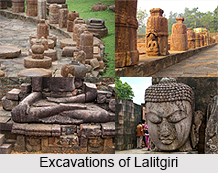 Lalitgiri is one of the major Buddhist pilgrimage centres in Odisha. Lalitgiri and the archaeological ruins is now a major tourist attraction in India.
Lalitgiri is one of the major Buddhist pilgrimage centres in Odisha. Lalitgiri and the archaeological ruins is now a major tourist attraction in India.
Location of Lalitgiri
Lalitgiri is a Buddhist complex of Odisha.
Archaeological sites of Lalitgiri
Lalitgiri is part of Puspagiri University located on top of hills of the same names. The three complexes are known as the "Diamond Triangle". There Tantric Buddhism is practised in Lalitgiri.
Geography of Lalitgiri
Lalitgiri is a major centre of Buddhism hemmed between the Parabhadi and Landa sandstone hills in the standalone Asian hill range. It is situated in the Mahanga Tahsil in Cuttack district. Bhubaneswar, the state capital of Odisha which is 90 kilometres (56 mi) from the site, while Cuttack is 60 kilometres (37 mi) away; Udaigiri is 8 kilometres (5.0 mi) from Lalitgiri and Ratnagiri is a further 5 kilometres (3.1 mi) away. Bhubaneswar is well connected by road, rail and air services with the rest of the country.
Discovery of Lalitgiri
The first identification of archaeological antiquities from the Diamond Triangle sites was conducted in 1905 by M.M. Chakravarty, the then Sub Divisional Officer in Jajpur District. Later, in 1927 and 1928, R.P. Chanda of the Indian Museum in Kolkata, West Bengal documented the site in the Memoirs of Archaeological Survey of India. In 1937, the site was officially declared a protected monument by the central government. In 1977, some excavations were done at the site by the Utkal University. Detailed excavations by the Bhubaneswar Circle of the Archaeological Survey of India were conducted between 1985 and 1991. From these investigations, it has been inferred that Lalitgiri, one of the earliest Buddhist sites in Odisha, maintained a continuous cultural sequence starting from the post Mauryan period till 13th century. It is also inferred that this site maintained a continuous of presence of Buddhism, unbroken, from 3rd century BC to 10th century AD. In 1985, the Archaeological Survey of India started excavation at Lalitgiri to locate Pushpagiri, an important Buddhist site mentioned in the writings of the Chinese traveller Hiuen Tsang. The excavation led to several important archaeological discoveries, but none of these confirmed the identification of Lalitgiri with Pushpagiri. Later, excavations at Langudi Hill suggested that Pushpagiri was located there.






































